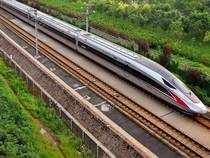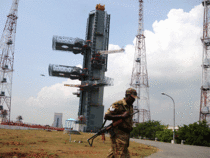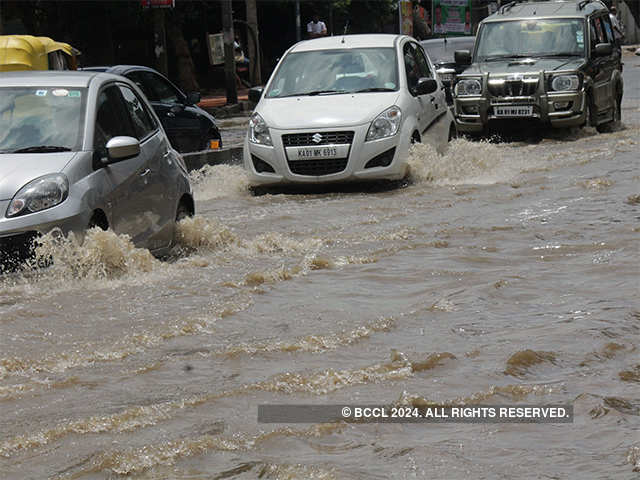Heavy rains on Tuesday pummelled Mumbai and adjoining areas, disrupting rail, road and air services and threw normal life out of gear.
IMAGE: A car stuck on a heavily water-logged road in King's Circle area of Mumbai after very heavy rains since Monday night. Photograph: Sahil Salvi
Besides the metropolis, adjoining Navi Mumbai and Thane regions were also lashed by incessant downpour since Monday night, delaying suburban train services and leaving vehicles crawling through waterlogged roads in low-lying areas.
As the financial capital stopped in its tracks, no respite was in sight as the Meteorological Department forecast ‘extremely heavy rainfall’ in the next 24 to 48 hours in the western coast of Maharashtra, including Mumbai, and parts of Gujarat and Goa.
IMAGE: Waterlogging was reported in low-lying areas. Photograph: Sahil Salvi
Traffic jams were reported on all major arterial roads, including the Eastern and Western Express Highway, Sion-Panvel highway and LBS Marg as the rains continued since Monday night.
Waterlogging was reported in low-lying areas of Parel and Sion. A tree fell on the busy Saat Rasta road, affecting road traffic.
IMAGE: Suburban services were disrupted with trains on all the three lines -- western, central and harbour -- running late. This is a top view of flooded tracks at Mahim station. Photograph: Afsar Dayatar/Rediff.com
Suburban services were disrupted with trains on all the three lines -- western, central and harbour -- running late. Waterlogging on tracks was reported in Andheri and Bandra, civic officials said.
The city airport saw flight disruptions since morning.
Due to heavy winds and downpour since morning, six to seven flights had to do rounds while landing, while four to five flights were diverted to nearby airports.
These included an IndiGo Guwahati-Mumbai flight which was diverted to Ahmadabad, airport officials said.
IMAGE: The Brihanmumbai Municipal Corporation advised citizens to step out of their homes only if necessary. Photograph: Sahil Salvi
The single runway of the airport was, however, functional.
A Chhatrapati Shivaji International Airport spokesperson said there is an average delay of 35 minutes.
“Heavy rains and strong winds have drastically reduced visibility leading to diversions and go around even though the main runway is open,” a Mumbai airport source told PTI.
IMAGE: The Meteorological Department has warned of more 'heavy intermittent spells' in the next few hours in Mumbai and its satellite cities. Photograph: Sahil Salvi
Suburban rail services, the lifeline of the metropolis, were paralysed.
The Central Railway-run harbour line, which connects Chhatrapati Shivaji Maharaj Terminus to Panvel, remained suspended since 11:30 am, railways officials said.
Traffic snarls were witnessed on the Eastern Freeway, Dr B R Ambedkar Road, Western Express highway, Joint Commissioner of Police (Traffic) Amitesh Kumar said.
IMAGE: Many roads were flooded, causing heavy traffic jams. Public transport was also badly hit. Photograph: Sahil Salvi
The Brihanmumbai Municipal Corporation said the situation was well under control and advised citizens to step out of their homes only if necessary.
“The metropolis has received heavy rainfall since last (Monday) night. Between 8.30 am and 12 pm today (Tuesday), the city received 85 mm rainfall,” Sudhir Naik, Deputy Municipal Commissioner, told PTI.
"Step out of homes only if it is too important because water-logging has been reported from several parts of the city," he said.
IMAGE: Currey Road station on the Central Railway Line. Train services have been disrupted owing to the heavy flooding on the tracks. Photograph: Sahil Salvi
Naik, however, added things were well under control and senior civic officials were keeping a close watch on the situation.
‘Due to water-logging on tracks and point failure at Bandra following very heavy rains, 3 lines except UP Fast line are affected. Efforts are on to start traffic on 3 lines (except UP fast line) at Bandra as soon as possible by attending the points,’ the Western Railway tweeted.
IMAGE: A tree fell on a moving car at Marol Military Road in Andheri (East). The driver was not injured. Photograph: Harish Kotian/Rediff.com
According to an official from the BMC’s Disaster Management Cell, "There have been reports of water-logging in Dadar, Andheri, Worli, Kurla and Sakinaka, among other areas. We have received 20 cases of trees falling and one of a wall collapse."
“Despite heavy downpour, no untoward incident has been reported so far,” said the official.
“Areas such as Mumbai, south Gujarat, Konkan, Goa and West Vidarbha will get extremely heavy rainfall in the next 24 to 48 hours. It is a serious situation. We have issued necessary warnings to the departments concerned, including airports,” A K Srivastav, head of climate monitoring and analysis at IMD Pune, told PTI.
IMAGE: Water entered houses in low-lying areas due to heavy rain. Photograph: / Rediff.com
“The status of the weather system, which has brought heavy showers over the Mumbai region, has been upgraded from ‘well marked low pressure’ to ‘depression’. It means it is set to bring more rains. Hence, we have predicted an extremely heavy rainfall,” he said.
In the morning, commuters bound for offices were stranded at several suburban stations.
IMAGE: Commuters stranded at a bus stop in Gandhi Market, King's Circle.
Photograph: Sahil Salvi
In absence of train services, major suburban stations were overcrowded. Chhatrapati Shivaji Maharaj Terminus was chock-a-block with commuters anxiously waiting for trains to head home.
Actor-turned-entrepreneur Gul Panag tweeted, ‘Brace yourself Mumbai. Heavy rain coming. Plan ahead. Stay safe.’











